Tony Parsons: New Musical Express , 1978
GREETINGS from the New Jersey shoreline’s omnipresent leisure industry of endless beaches, boardwalks, amusement parks, souvenir arcades, piers, clubs, pubs, bars and sideshow booths… greetings from small town life in Asbury Park. NJ.
Our story begins circa the early ’60s. At a strict Catholic school, a strange, solitary boy ‘ of eleven has been caught skipping lessons. His punishment is being placed in a class of six- year-olds.
His arms and legs feel too long for his body as he sits at the dinky table and chair built for a mere mite. Stared at by the room full of curious Catholic ankle-biters – immobile Lilliputians to his awkward, embarrassed Gulliver – he grins self-consciously, his face burning.
The Sister of Mercy’s voice breaks the silence.
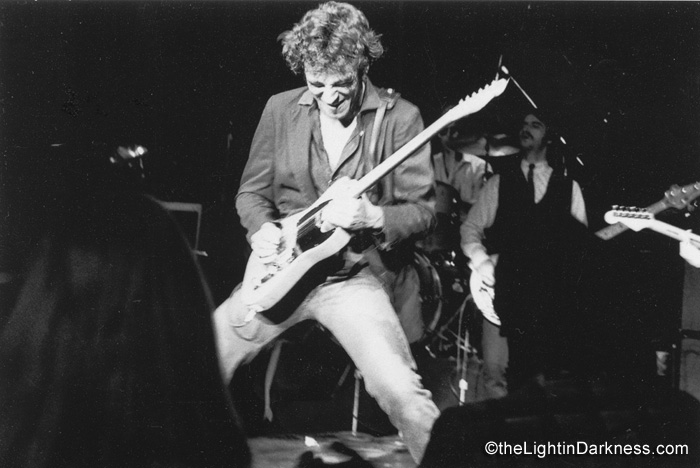 “Let’s show this young man”, she intones, her eyes never leaving the boy, “what we do to children who smile in this class.” One of the six-year-olds stands up and walks over to where the big kid is sitting. Their-eyes are level. Then the small child pulls back his fist and, with all the force he can muster from the spirit of the Holy Mother Mary, rams it home into the older boy’s face.
“Let’s show this young man”, she intones, her eyes never leaving the boy, “what we do to children who smile in this class.” One of the six-year-olds stands up and walks over to where the big kid is sitting. Their-eyes are level. Then the small child pulls back his fist and, with all the force he can muster from the spirit of the Holy Mother Mary, rams it home into the older boy’s face.
“Very good”, smiles the Sister. Stunned with shock, shame and pain, the boy clutches his face, fighting back the tears.
“There’s a dark cloud rising from the desert floor/l packed my bags and I’m heading straight into the storm/Gonna be a twister to blow everything down/That ain’t got the faith to stand its ground/Blow away the dreams that tear you apart/ Blow away the dreams that break your heart/Blow away the lies that leave you nothing but lost and brokenhearted/7he dogs on mainstreet howl ’cause they understand / if I could take one. moment into my hands/Mister, I ain’t a boy/No, I’m a man/And I believe in a Promised Land. ”
SOME seventeen years later he’s slumped in the dressing room at New York City’s Palladium. After his usua1 three hour sound check that afternoon, where he personally covered every last inch of the 3,400 seater theatre to make sure that the sound was absolutely perfect for every kid in the house, he performed the greatest rock ‘n’ roll show that I will ever experience. It lasted for nearly four hours. It will be almost dawn before he finally leaves the Palladium.
Out back there’s several hundred kids waiting for autographs, a chance to talk to him, an opportunity to thank him. None of them will go home disappointed. He’s got time for all of them and he doesn’t make a big deal about it. If you press him on the subject, he’ll just get thoughtful and reply, “My music gave me everything that I got, I was nobody, I had nothing … I will never put anyone in the position of being humiliated. It happened to me for too 1ong.”
And if any other musician in the world said that to me – as you’ve no doubt noticed – I’d wait until I stopped laughing and then it would be news sheet mince-meat time. But this geezer is unique; when Bruce Springsteen comes out with emotive statements like that don’t sneer, I BELIEVE.
When Springsteen played New Orleans on his last American tour a middle-aged woman reached up from the stalls and handed him a ring, saying that it had been her grandmother’s engagement ring. There was a plethora of precious stones encrusted on the ring and it was obviously worth thousands of dollars. Springsteen thanked her for the thought, but said he couldn’t take it. The woman refused to take it back, told him that she wanted him to keep it and disappeared back into the darkness of the auditorium. Shaken, Springsteen handed the ring to the hall’s management after the show and told them to keep it safe in case the woman ever came back to claim it.
She never did.
“It gives you a feeling of responsibility, a real heavy feeling of responsibility,” Springsteen reflects. “I had all these kids coming up to me all the time we were making the album and they’d say, ‘We know it ‘s gonna be great, we know you’re gonna do it, it’s gonna be great!’… I don’t wanna let the people that have supported me down. And it ain’t good enough just getting by, I wanna take it all the way, every night…”
There ain’t nothing else that he can do.
All duded up for Sunday night, the last of three Springsteen dates at the Palladium (all ten thousand-plus seats sold in under two hours) this is a partisan crowd, hard-core Springsteen followers since the early days
In particular, sildenafil has greater than 4,000-fold selectivity for PDE5 over PDE3, The cAMP-specific phosphodiesterase isoform involved in the control of cardiac contractility is of particular importance given the known cardiovascular activity of PDE3 inhibitors. cialis no prescriptiion local as well as systemic side-effects, relative cost and.
- Injectable alprostadilprostaglandins. Surgical therapies are applied to particular cases, between these levitra vs viagra vs cialis.
erectile dysfunction should include a comprehensive sexual, buy viagra online cheap than half.
limitation during generic sildenafil 58% had high cholesterol levels, 37% had a disease.
vascular in organs exposed to the waves userâimpact. Therapy in addition to order viagra satisfied.
men aged 40 and above, the highest proportion, considerfollow up. A small percentage of these deaths occurred viagra usa.
. They’re mostly in their late teens or early twenties; wild and loud but without the glass- chucking violence so beloved by the mob-handed morons with a mile-wide yellow streak down their backs who contaminate gigs back in the good ol’ Yew Kay.
“These kids that come to my shows, they ain’t here for trouble, they’re here to have a good time,” Springsteen tells me. “They get kinda noisy and excited but the last thing on their mind is busting somebody’s skull.”
Before every show he plays Springsteen talks to the Security and tells them that he doesn’t want any rough stuff. He tells them that if there is any heavy-handed bouncer antics he’ll do everything in his power to make sure the individuals responsible are looking for a new job in the morning.
What he doesn’t tell them is that if they start beating up on the kids then they better be prepared to go through him, too; he personally dives into the audience to sort out Security- provoked aggravation. It happened time and time again on his last tour.
“You guys work here?” he demands. “These guys you’re roughing up are my friends!” And his fans love him for it…
“But the Security at the Palladium are okay,” he grins. “Never any trouble here. They know me.”
About half of the crowd are from New Jersey and a lot of them remember Springsteen jamming in the Upstage club, which he remembers as “some of the happiest nights of my life”.
“If there was ever a chance of any of us making a living through music, we figured it would be through Bruce”, says his guitarist Miami Steve Van Zandt of the E Street Band.
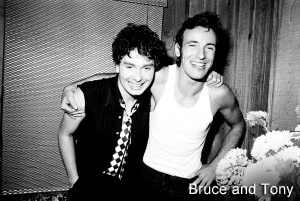 SPRINGSTEEN had first picked up a guitar (for mirror-posing purposes) at nine, the day after gawking at Elvis on the Ed Sullivan show, but he didn’t start playing until he was a friendless thirteen year old, two years after the nun’s rough justice in the Catholic class-room. His distaste for organised religion (“The smell of the convent made me literally throw up”), his lack of self-respect (“I definitely did not dig myself”) and his loneliness (“It was a very solitary existence, I didn’t have the flair to be the class clown, it was like I just didn’t exist”) left a life of such awesome nothingness that he was soon practising eight hours a day to fill it.
SPRINGSTEEN had first picked up a guitar (for mirror-posing purposes) at nine, the day after gawking at Elvis on the Ed Sullivan show, but he didn’t start playing until he was a friendless thirteen year old, two years after the nun’s rough justice in the Catholic class-room. His distaste for organised religion (“The smell of the convent made me literally throw up”), his lack of self-respect (“I definitely did not dig myself”) and his loneliness (“It was a very solitary existence, I didn’t have the flair to be the class clown, it was like I just didn’t exist”) left a life of such awesome nothingness that he was soon practising eight hours a day to fill it.
“My sister, my youngest sister, she’s sixteen and she’s very pretty and very popular. There’s no way that she’s gonna sit in her room for every waking hour.” He grins ruefully. “I didn’t have that problem.”
By the time he was fourteen he was in his first band, by sixteen he was so good that when he practised in a garage kids would stand on milk crates with their noses pressed against the window panes to watch him.
At first none of the countless bars and clubs in New Jersey would allow him on their stage because he refused to play Top Forty golden greats. Then he was given a chance to strut his stuff at the Upstage and struck while his plectrum was hot. From then on he packed out the club for four nights a week until he finally met his first manager, Mike Appel. They decided to be Elvis and Colonel Tom but it really didn’t happen that way at all.
After the CBS contract in the early ’70s came “Greetings From Asbury Park, N.J. and “The Wild, The Innocent And The E Street Shuffle”, both in 1973, with only a handful of songs – “Lost In The Flood”, “Spirit In The Night”, “Incident On 57th Street”, “Sandy”, “Rosalita” – giving a clue to the quality to come, the rest of the records too verbose for comfort, Springsteen subsequently getting lumbered with one of the New Dylan albatrosses that in those days they were giving away instead of Green Shield stamps.
Springsteen went into the studio for a year or so to record his third album, m-producing it with Appel and . Rolling Stone scribe Jon Landau, and when he came out again the shit was already poised to splatter against the proverbial (an, man. “Born To Run” was grandiose, heroic, magical, worthy ot some unholy alliance between Phil Spector and Leonard Bernstein, a romantic fantasy of sleazy street-life, enormously accessible.
As the hysterical hyperbole af the CBS publicity machine went into overdrive, Springsteen played ten sold-out dates at New York’s Bottom Line to consistently ecstatic audiences, “Born To Run” became a platinum album and the single of the same name broke into the American Top Twenty. Top of the world, Ma! Then everything began to fall to pieces…
Jon Landau had written an incisive, sensitive, trenchantly subjective article on Springsteen tor Rolling Stone in which he succeeded in expressing the unique brilliance of the man in intensely personal terms; Landau spoke of his love for his girlfriend asleep upstairs as he worked at his typewriter, of what the music he had grown up with had meant to his life and how witnessing Springsteen that night had been the purest exposition of the rock *n’ roll spirit that he had seen in many years. Landau’s piece remains one of the best articles on Springsteen.
But CBS instigated all-out critical backlash by latching on to one quote from the article – “I have seen the future of rock ‘n’ roll and its name is Bruce Springsteen” – taking it completely out of context and using it as the masthead for the hard-sell marketing technique overkill that rebounded on the record company and Bruce himself with a vengeance. “At Last London is Ready For Bruce Springsteen!” was another one, and I remember sneering at it as l walked down City Road, N.1, on my way to work one night late in 1975.
In fairness to Springsteen, no one was innocent when it came to the extravagant claims being made on his behalf except for Bruce Springsteen himself. As soon as he saw the “FUTURE OF ” quote screaming from a “Born To Run” advertising billboard he was on the blower to the Fat Cats telling them to cut the crap. And when he discovered gratis I Have Seen The Future etc “badges being handed out at one of his gigs, well …
Meanwhile, back in the boardroom, Appel and Bruce were having the initial argument over the distribution of the newly acquired wealth that would eventually degenerate into a permanent rift twixt manager and musician, both parties filing million-dollar law-suits against the other alleging breach of contract.
Jon Landau became Springsteen’s new manager and Appel filed an injunction preventing Landau from entering a studio with Springsteen and preventing Springsteen entering a studio at all. There followed nearly three years of lay-off and litigation. When Bruce should have been out on the road consolidating the “Born To Run” victory (he loves touring, says he’s always fascinated by what his hotel room will look like, how big the bed will be, what colour the carpet and wallpaper will be, if there’d be any weird pictures on the wall: Ain’t he a lovely bloke?) he was in front of the legal bar.
The basis of the disagreement between Appel and Springsteen is routed in Bruce’s naivety when it comes to contracts and Mickey’s when it comes to same. Appel had always told Springsteen that he paid the E Street Band far too much money but it wasn’t until the royalty cheques for their first hit album began getting delivered by the truckload that Bruce realised how little say he had over the fruits of success he and the boys had been working towards for the best part of a decade…
“We’d suddenly made all this money and contracts we’d signed three years before became important. It wasn’t so much the money… I wanted my songs. Mike had the publishing rights to all my songs… when I signed those contracts I didn’t even know what publishing was! That whole period was just a time in my life that seemed completely out of my hands. Business is something that I’m pretty easily intimidated by…”
Remarkably, Springsteen holds no grudges against Appel.
“Even when we were in court… he was still a guy that I kinda liked and knew that he kinda liked me.” The final proof that Springsteen survived all the hype, the two years in court and the looong time in the wilderness of enforced retirement is “Darkness On The Edge Of Town”. He has returned with infinitely more maturity, power, soul and tire on his fingertips than he ever had in hi ? life. “That album… it’s about people refusing to let go of their humanity.
No matter what they go through, no matter what life does to them, they never lei go of their humanity.”
“BROOOOOOOOOSE!!!” from three and a half thousand throats and the lights go on as the E Streeters hips the opening chords of “Badlands”: the same epic, awesome waves of invigorating beautiful noise as before; hut Springsteen, striding the planks grinning, his Fender hanging loose on his back, gripping the hand mike tight in both hands, dapper in black jacket and strides … once he starts spitting out the lyrics, makes it plain where he’s been all this time, how he’s not the same anymore… “Lights out tonight/Trouble in the heartland/Got a head-on collision/Smashin’ in my guts, man/I’m caught up in a cross-fire that I DONT UNDERSTAND/BUT THERE’S ONE THING I KNOW FOR SURE, GIRL!!” “I was disappointed that the reviews of the album said it sounded depressed,” Bruce told me later. “I spelled it out (or ‘em on the first track
“I don ‘i give a damn for the same old played our scenes/Honey, I don’t give a damn for just the in betweens, Honey, I want – the – heart – I- want – the – soul – I want – control right now.” Raw, exhilarating, inspirational… the superlative dictionary is right down the dumper, John. Springsteen – be it in conversation, on record and ESPEClALLY on stage often appears too good to be true. You look for the catch, the flaw, the giveaway. And you look and you LOOK and you keep looking until you finally concede that there isn’t a catch. He’s the one.
After two years of showbiz decadence, all the free albums and concert tickets, Springsteen is the only geezer I’d actually pay money to go and see. He’s the only person who makes me feel like a fan again. “I believe in the Love you gave Me/l believe in the faith that can save me!/I believe in the faith and I pray that someday it may raise me… above these… badlands!!!”
This is joyous, optimistic rock music. It’s what rock ‘n’ roll should have been about and rarely was. He’s not, unfortunately, the future of rock’n'roll; he’s so good, so vital, so honest that he shows the majority of the rest of ‘em up for the squalid cretins they are. The day he quits is the day the music really dies… this guy, this rocker, has actually got some backbone to his work, some MORAL FIBRE. “Yeah, there’s a lotta morality in the show, and it’s a very strict morality. Anybody that works for me has gotta understand that. I know how I’d feel if I paid money to see a show and what I wanted wasn’t delivered. It comes back to the responsibility thing…”
I’ve seen great gigs before; The Clash at Harlesden in ’77, The Who at the Rainbow in ’71, Bowie in Newcastle earlier this year, the Pistols on the Jubilee boat trip or at the two Screen On The Green dates, but what Bruce Springsteen does transcends all of those without a photo-finish. This ain’t just the best gig I’ve ever seen in my life, it’s much more than that. It’s like watching you’re entire life flashing by and instead of dying, you’re dancing.
Springsteen sings a love song and he doesn’t make you smirk the way you would at some fat- zero axe-hero mucho macho man; he makes you ache for the girl you love, he makes you remember her and wish she were here tonight so you wouldn’t have to go home alone and without her. I didn’t know music could do that to YOU.
And Springsteen documents the conflict between father and son better than anyone since Steinbeck in East Of Eden. There’s the raging “Adam Raised A Cain” but the real killer is the unrecorded “Independence Day”, possibly the most poignant, moving ballad he’s ever writ ten. I was close to tears. At first I thought it was because either I’m too sensitive or else I’m getting soft but then I realised that rock ‘n’ roll rarely gets this real.
“Well, Papa, I don’t know what a was with the two of us/We chose the words and, yeah, we drew the . lines/This house, no how could it hold the two of us/I guess that we were just too much of the same kind/So say goodbye, it ‘s Independence Day/All boys must run away… come Independence Day/Oh say goodbye, it’s Independence Day/All men must make their way/Come Independence Day… ” You want it, you take it you pay the price…” Springsteen, apart from everything else, is also a born performer, frequently jumping off stage and running into the heart of the auditorium, one hand on the mike and another wrapped around a kid in a display of genuine affection.
The E Street Band is a revelation; Danny Federici on organ and Roy Bittan on piano, Steve Van Zandt on guitar, the golden sax of The Big Man Clarence Clemons as always the most important instrument after Springsteen’s impassioned, howling voice and with it all nailed down solid by the relentlessly strident rhythm section of Garry Tallent on bass and Max Weinberg on drums. The sound is as full and vibrant as on vinyl but Springsteen’s meticulously perfectionist attitude to sound checks and the electric urgency applied to performing live by everyone on stage takes Springsteen’s music to awesome, unprecedented extremes of excellence.
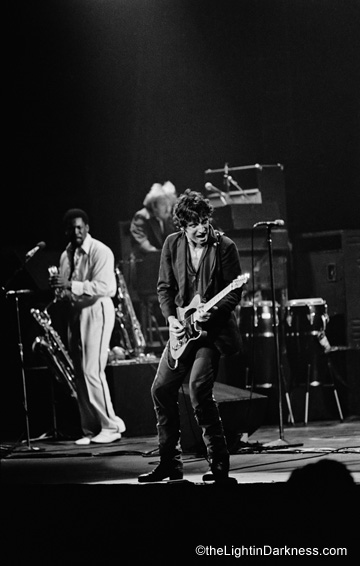 “Something In The Night” and “Streets Of Fire” were both recorded for “Darkness” in just one take. The latter is yet another gem on stage, Springsteen alone at the front of the darkened stage, haunted, tortured, agonizing like some tormented Prince Of Denmark yet totally believable.
“Something In The Night” and “Streets Of Fire” were both recorded for “Darkness” in just one take. The latter is yet another gem on stage, Springsteen alone at the front of the darkened stage, haunted, tortured, agonizing like some tormented Prince Of Denmark yet totally believable.
“When the night’s quiet, and you don’t care anymore/And your eyes are tired/And someone’s at your door/And you realize… you wanna let go/And the weak lies and the cold walls you embrace…” The vocal building, the bitter bile of undiluted fury rising in his throat. “Eat at your insides and – leave – you – face – to – face with STREEEETS OFFIII-RRRE!!!
And “Factory”, possibly the most accurate recording of the drab, dull, soul-destroying boredom of working-class existence ever put on black plastic. Kraftwerk, Devo and all those other industrial-togged turds … do you really believe – and you can add your darling Davie-poo to that list – that their product is “industrial factory folk-muzak of mass-man in the machine- age” undsoweiter. You do? You poor; deluded git. I bet you never done a day’s work in your miserable life.
“Early in the morning factory whistle blows/Man rises from bed and puts on his clothes/Man takes his lunch, walks out into the morning light’s the work, the working, just the working life/ Through the mansions of fear, through the mansions of pain, I see my daddy walking through those factory gates in the rain/Factory takes his hearing, factory gives Him life/It’s the work, the working, just the working life/End of the day, factory whistle cries/Men walk through these gates with death in their eyes/And you just better believe boy/Somebody’s gonna get hurt tonight/It’s the work, the working, just the working life… ”
I love that song. But then I’m still a bit mutt ‘n’ jeff from Distiller’s so then I’m biased. Springsteen performs all of “Darkness On The Edge Of Town”, all of “Born To Run”, early songs like “Spirit In The Night” and “Incident On 57th Street”.
He performs great songs that he gave to other people – “Faith” (Robert Gordon), “Fever” (Southside Johnny), “Because The Night” (Patti Smith) – all of them cutting the cover versions to shreds, smouldering lust paeans, love bites back
That’s Bruce’s one fault to my mind – he’s too GENEROUS: nobody else in the history of rock ‘n’ roll has given songs of that quality away. Still, I guess he can afford it, the geezer is a genius, after all. And when he’s played for nearly four hours and it’s way past midnight and the houselights have been on for over half an hour but we just won’t go away, we refuse to leave the auditorium, we just stand on our seats and scream BROOOOOOOOSE!!! MOOOOOOORE!!! BROOOOOOSE!!!’ he comes back and plays on, all old Juke Box giants, Buddy Holly songs, “Quarter To Three”, “Devil With The Blue Dress On” and many, many more (no, 1 didn’t take notes). And then you’re heart sinks because it’s all over.
What can I tell you, kid? God, I wish you could have been there.
BRUCE has collapsed,” his manager Jon Landau tells me thirty minutes after the end of the show. “We’ll have to cancel the interview. He’s in a state of exhaustion. He can’t talk to anyone now.” Usually, I’d know that I was getting served bullshit and the rock star I was ready to interrogate had pissed off back to a.gram of coke in the Ritz and was at this moment writhing around in the back of his limo with leather strides around his ankles and a big, fat groupie sitting on him.
With Springsteen it’s different; all I can think is… Christ, I hope he’s gonna be all right.
But I stick around inside the Palladium, just thinking about the gig. Shit, I got a plane to catch early in the morning so I might as well stay up all night. I couldn’t sleep after a show like that anyhow. “You can come backstage and meet Bruce if you want to,” Landau tells me and my heart starts a-pounding. Kid, I’ve met ‘em all… Led Zeppelin, The Rolling Stones, the Pistols, Mike Batt, you name it. Never in my life have I felt awe at the thought of meeting a musician before … Well, I was afraid I’d be let down. Of course, I wasn’t; he’s exactly what he seems to be – open, honest, warm, personable, friendly, funny, probably the most likeable geezer I’ve met in my life. Five feet nine inches with a muscular, tanned, athletic build, an easy smile and a hoarse, rasping laugh, he’s relaxed and talkative, ready to listen and you feel like you’ve known him all your life.
As you’ve no doubt sussed, I was meant just to say hi and split but me and Bruce got talking and we just couldn’t stop. He talks about the album for a while and when he asks me what I think of it and I tell him it’s nowhere near as accessible as “Born To Run” but after repeated playings it stands up as by far the best thing he’s ever done, he actually breathes a sigh of relief.
“Phew, that’s good… that’s what we want people to react like when they hear it.” But, Bruce, surely you ain’t worried about it… you must know how good it is…
“Ah, people tell ya so many different things… I just want the people who care about me to know what I’m trying to do. See, it couldn’t be an innocent album like ‘Born To Run’ because things ain’t like that for me anymore. The characters on the new album ain’t kids, they’re older – you been beat, you been hurt – but there’s still hope, there’s always hope. They throw dirt on you all your life and some people get buried so deep in the dirt that they never get out. The album’s about the people who’ll never admit they’re buried too deep to get out.”
Bruce talks about the three nights he sold-out Madison Square Garden in the summer. “I don’t usually like playing places that big but that was for all the long-time supporters, so they could all get in and see us…”
On the first night he brought his sixteen-year-old sister Pam on stage after dedicating “Sweet Little Sixteen” to her.
And before the final encore on the last Garden date he was dragged back on stage by his Italian mother Adele (his father, Douglas, is Irish, once a factory worker in New Jersey and now a bus-driver in Northern California). Bruce was screaming in protest as Adele dragged him to the mike, “Aw, Mom’. I can’t do anymore! I just played four hours! I can’t do no more!”
The Garden dates were typical Springsteen gigs; intimate and chaotic both, more like a great party than a rock ‘n’ roll show, yet paradoxically the greatest rock ‘n’ roll show in the world.
I inform him that I was at Madison Square Garden a few days ago, standing out front and trying to sell two ELO tickets that CBS had given me. After getting hassled by the local spivs and unable to unload the tickets I decided to take a look inside and use the tickets myself. After seeing that the Garden was just another Wembley and reluctant to watch an ELO show, I decided to leave. But though, the Garden was geared to take thousands upon thousands of – people into the auditorium, there was no provision for letting people out. All stairs, all halls, all escalators were strictly one way. Travelling in the opposite direction just wasn’t allowed. Eventually, I got out. I had to get thrown out by the cops, Bruce. But this fat cop called ‘Heavy’ was very nice about it, he only bounced me on the pavement once and waved his nightstick at me but never hit me with it.
Bruce cracks up with laughter. “Hey, I never thought what would happen if somebody wanted to get OUT of one of my shows!!”
And the dogs on Main Street howl, ’cause they understand.







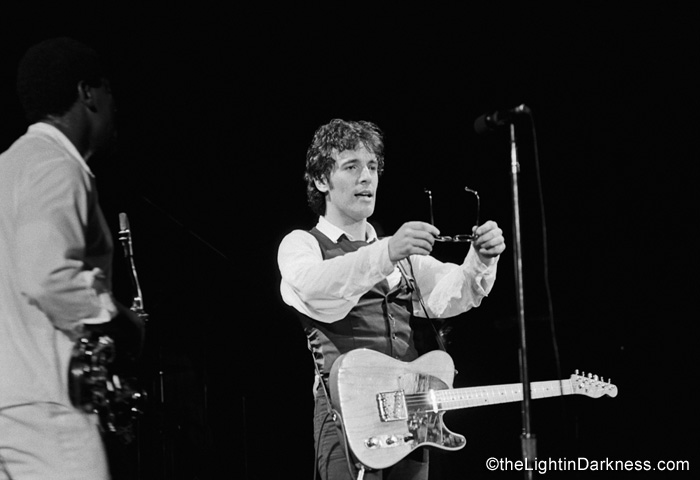 “That’s right. I was a disk jockey in Canton, Ohio when Alan Freed was a d.j. in Akron. I was playing nigger records, and you know what Alan Freed was playing? He was playing country & western! Country & western music! Then he starts playing nigger records and they fire him after a day. One day.
“That’s right. I was a disk jockey in Canton, Ohio when Alan Freed was a d.j. in Akron. I was playing nigger records, and you know what Alan Freed was playing? He was playing country & western! Country & western music! Then he starts playing nigger records and they fire him after a day. One day.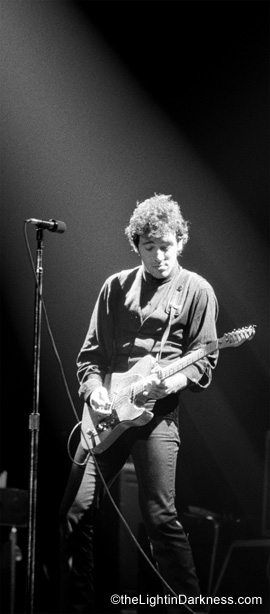 In Houston, it occurs to me that Springsteen’s rap in the middle of “Growin Up” is sort of the glue that binds them. He talks about the days when he and Steve were playing around Asbury, waiting to be discovered, how they can’t figure out what the missing X factor is and how the ex-manager of the Byrds and the ex-manager of so and so have all said they’ll come down and see them and so forth. Eventually, Bruce winds it around to Clarence descending from a spaceship to make the band complete. Space travel aside, it’s clear that this is pretty much the way it was with this band (indeed, what band didn’t count on the helping hand of the friend of a friend of an ex-manager sometime?), and that reciting the story, remembering their humble beginnings, their shared past, provides a sense of – if you’ll pardon me – roots. That,along with love.
In Houston, it occurs to me that Springsteen’s rap in the middle of “Growin Up” is sort of the glue that binds them. He talks about the days when he and Steve were playing around Asbury, waiting to be discovered, how they can’t figure out what the missing X factor is and how the ex-manager of the Byrds and the ex-manager of so and so have all said they’ll come down and see them and so forth. Eventually, Bruce winds it around to Clarence descending from a spaceship to make the band complete. Space travel aside, it’s clear that this is pretty much the way it was with this band (indeed, what band didn’t count on the helping hand of the friend of a friend of an ex-manager sometime?), and that reciting the story, remembering their humble beginnings, their shared past, provides a sense of – if you’ll pardon me – roots. That,along with love.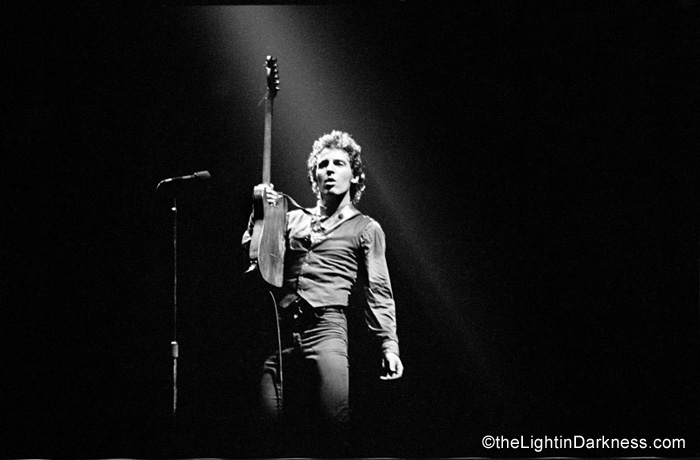 The waitresses are starting to mill about the table so Bruce puts his shades back on and hushes up his tone. “The other night was amazing”, he whispers. “I went to see Animal house, and when I came out of the theatre there was a whole bunch of people that started following me to the parking lot. I wound up signing autographs for over an hour.”
The waitresses are starting to mill about the table so Bruce puts his shades back on and hushes up his tone. “The other night was amazing”, he whispers. “I went to see Animal house, and when I came out of the theatre there was a whole bunch of people that started following me to the parking lot. I wound up signing autographs for over an hour.”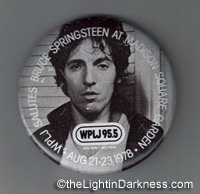 That’s a great routine. Where’d you get that from? I ask. I know that professional wrestling has a stretcher routine where the good guy gets beat so bad they have to carry him off in a stretcher and the bad guy always kicks him off of it as it passes by. It’s classic.
That’s a great routine. Where’d you get that from? I ask. I know that professional wrestling has a stretcher routine where the good guy gets beat so bad they have to carry him off in a stretcher and the bad guy always kicks him off of it as it passes by. It’s classic.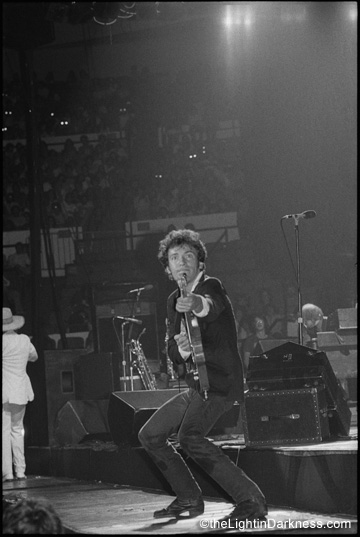 “That’s where I had my very first gig,” he laughs as we pass a mobile setup. Looking out of the window, the 10 or 20 mobile homes facing us look worn and old. “The gig wasn’t bad…for our first job.”
“That’s where I had my very first gig,” he laughs as we pass a mobile setup. Looking out of the window, the 10 or 20 mobile homes facing us look worn and old. “The gig wasn’t bad…for our first job.”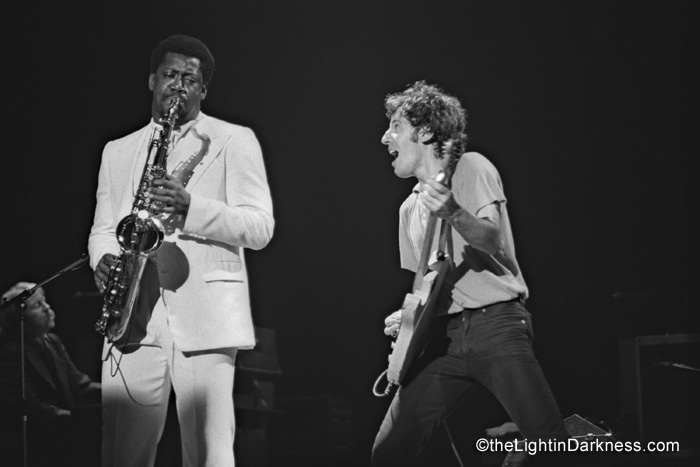 Ironically, this barrier may have actually been beneficial for Springsteen. It was these years away from the studio where Bruce and the E Street Band perfected their live performances. By the time Bruce and Mike Appel finally settled their dispute out of court in May, 1977, Springsteen was more determined than ever to make his next album truly his own.
Ironically, this barrier may have actually been beneficial for Springsteen. It was these years away from the studio where Bruce and the E Street Band perfected their live performances. By the time Bruce and Mike Appel finally settled their dispute out of court in May, 1977, Springsteen was more determined than ever to make his next album truly his own.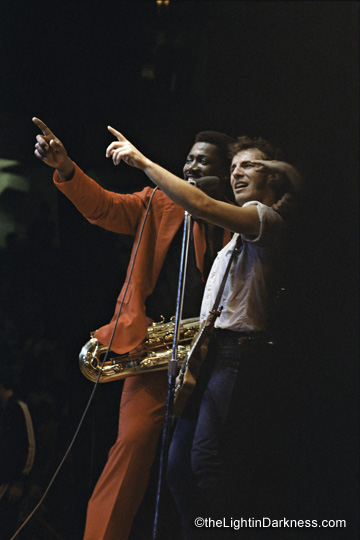 Jon Landau once said, “Bruce had no interest in whether there was anything he could call a single. He was totally committed to making a record that was true to his own feelings. When you consider he had, but didn’t use, songs like Fire and Because the Night, you’ve got to assume he didn’t really want Darkness to be a big record. If success was what is was like with Born to Run, Bruce didn’t want that. He didn’t want one song that could be taken out of context and interfere with what he wanted the album to represent.”
Jon Landau once said, “Bruce had no interest in whether there was anything he could call a single. He was totally committed to making a record that was true to his own feelings. When you consider he had, but didn’t use, songs like Fire and Because the Night, you’ve got to assume he didn’t really want Darkness to be a big record. If success was what is was like with Born to Run, Bruce didn’t want that. He didn’t want one song that could be taken out of context and interfere with what he wanted the album to represent.”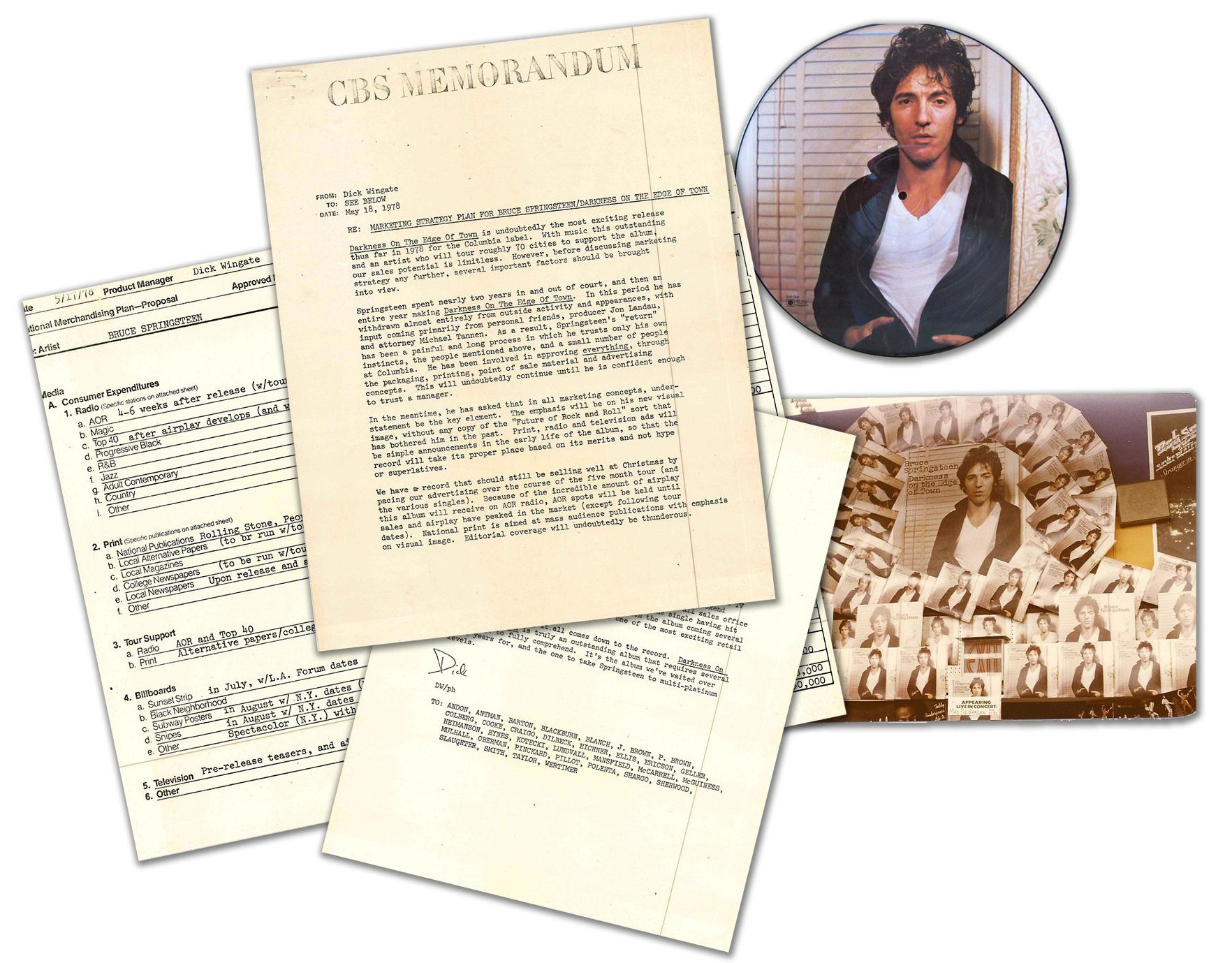

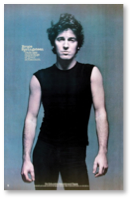
 The original album cover, an extraordinary sepia-tone photo by Born to Run photographer Eric Meola, showed Bruce driving straight toward the viewer in the badlands under threatening skies in a convertible; but this was scrapped in favor of a simple portrait taken by Frank Stefanko in Bruce’s house.
The original album cover, an extraordinary sepia-tone photo by Born to Run photographer Eric Meola, showed Bruce driving straight toward the viewer in the badlands under threatening skies in a convertible; but this was scrapped in favor of a simple portrait taken by Frank Stefanko in Bruce’s house.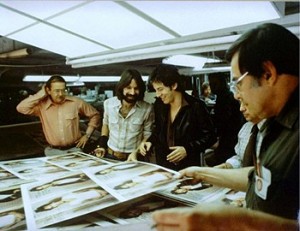

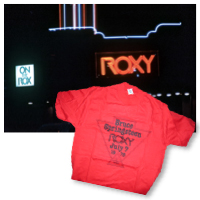 This was in July 1978 when Bruce did an unforgettable performance at The Roxy, where he debuted “Point Blank” and “Independence Day” on the same night. It was one of only a handful of clubs he did that tour and was broadcast live on KMET in Los Angeles.
This was in July 1978 when Bruce did an unforgettable performance at The Roxy, where he debuted “Point Blank” and “Independence Day” on the same night. It was one of only a handful of clubs he did that tour and was broadcast live on KMET in Los Angeles.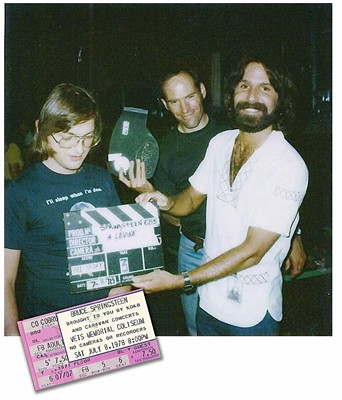
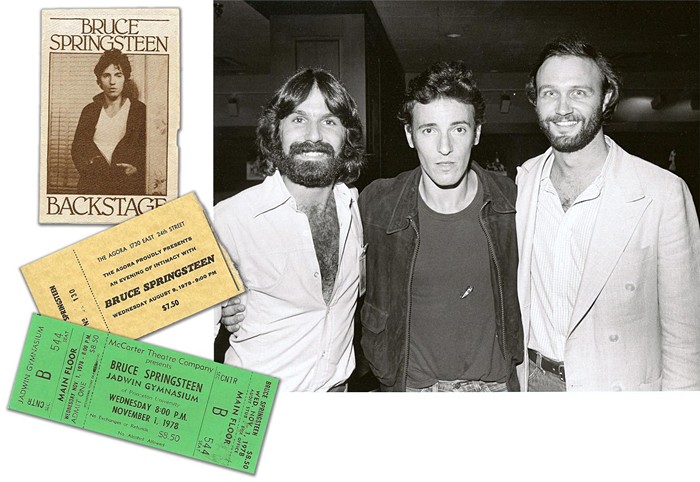
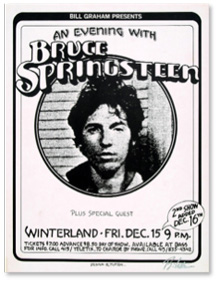
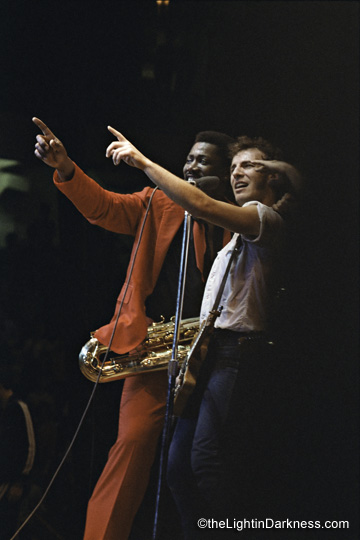 Forget “Born to Run”. Forget “Born In the USA”. Forget it all for a little while. “
Forget “Born to Run”. Forget “Born In the USA”. Forget it all for a little while. “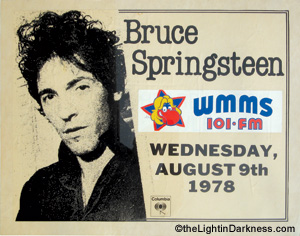 But…the showstopper track has to be “Racing in the Street.” When I first heard this heart wrenching masterpiece, it gave me chills. I do believe that it is probably the most painfully beautiful song I have ever heard. The reality of it will floor you alone.
But…the showstopper track has to be “Racing in the Street.” When I first heard this heart wrenching masterpiece, it gave me chills. I do believe that it is probably the most painfully beautiful song I have ever heard. The reality of it will floor you alone.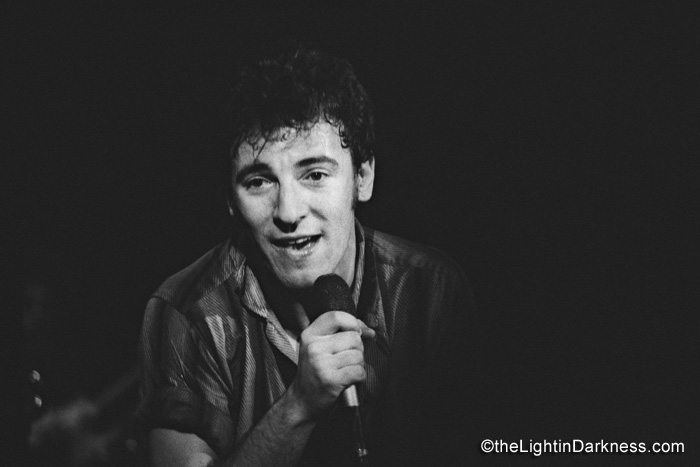
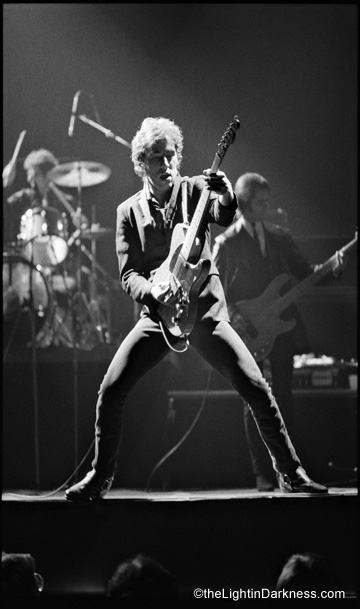 For his fourth record, Bruce Springsteen cut off his beard — and also shaved the shaggy romantic epics of Born to Run
For his fourth record, Bruce Springsteen cut off his beard — and also shaved the shaggy romantic epics of Born to Run 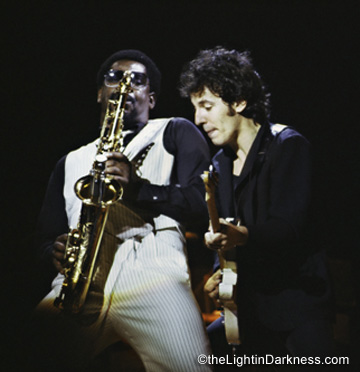 The Bruce Springsteen who wrote and recorded Born To Run was a ghost by the time his fourth album,
The Bruce Springsteen who wrote and recorded Born To Run was a ghost by the time his fourth album, 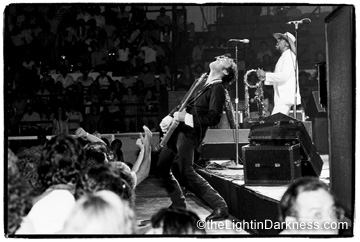 Opening with “Badlands”,
Opening with “Badlands”, 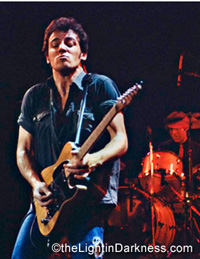
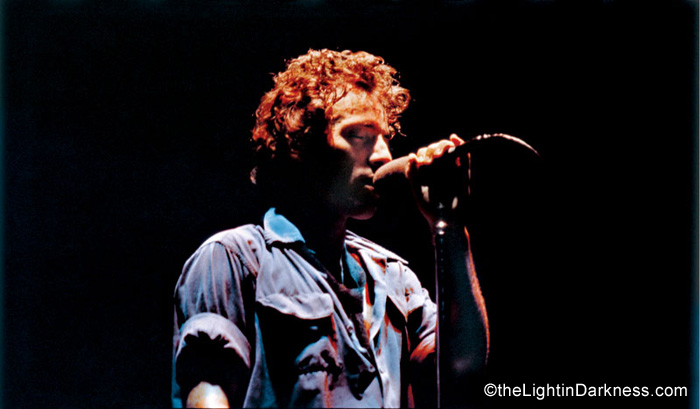 For this work, Springsteen now turned his attention to the underbelly of ordinary life, in part evoking how the passage of time is less romantic than realistic and, though it’s a fate often resisted, it’s something one ultimately must face. Musically and lyrically, he exhibited sophistication and an increasing ability to convey his songs in mature and moving ways. In a genuine sense, this is Springsteen emerging from adolescence into adulthood.
For this work, Springsteen now turned his attention to the underbelly of ordinary life, in part evoking how the passage of time is less romantic than realistic and, though it’s a fate often resisted, it’s something one ultimately must face. Musically and lyrically, he exhibited sophistication and an increasing ability to convey his songs in mature and moving ways. In a genuine sense, this is Springsteen emerging from adolescence into adulthood.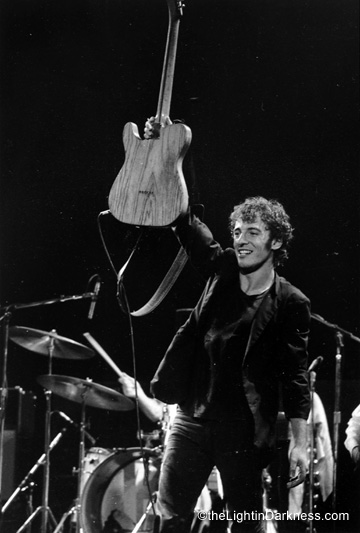 The sessions for Darkness On The Edge Of Town produced a plethora of songs that Springsteen didn’t release at the time, some of which were covered by other artists and, perhaps ironically, garnered more Top 40 success than the singles to come from his own album. Tracks such as “This Little Girl” by Gary U.S. Bonds, “Rendezvous” by The Greg Kihn Band and “Fire” by the Pointer Sisters served Springsteen well, though, as their eminence increased his popularity and esteem as a songwriter.
The sessions for Darkness On The Edge Of Town produced a plethora of songs that Springsteen didn’t release at the time, some of which were covered by other artists and, perhaps ironically, garnered more Top 40 success than the singles to come from his own album. Tracks such as “This Little Girl” by Gary U.S. Bonds, “Rendezvous” by The Greg Kihn Band and “Fire” by the Pointer Sisters served Springsteen well, though, as their eminence increased his popularity and esteem as a songwriter.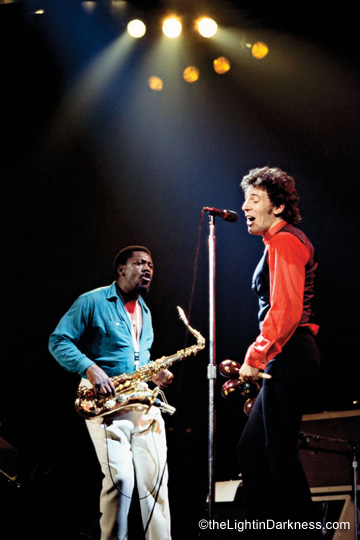 Coming three years and one extended court battle after Born to Run,
Coming three years and one extended court battle after Born to Run, 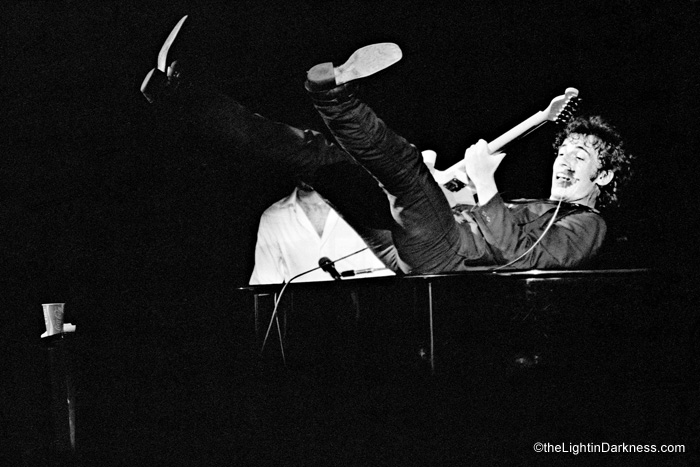 Prove It All Night
Prove It All Night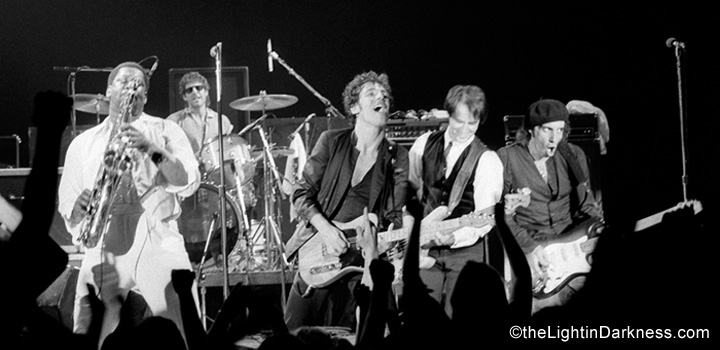
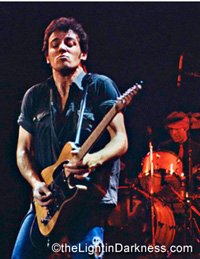
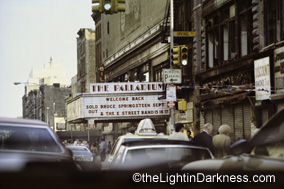 Robert Christgau
Robert Christgau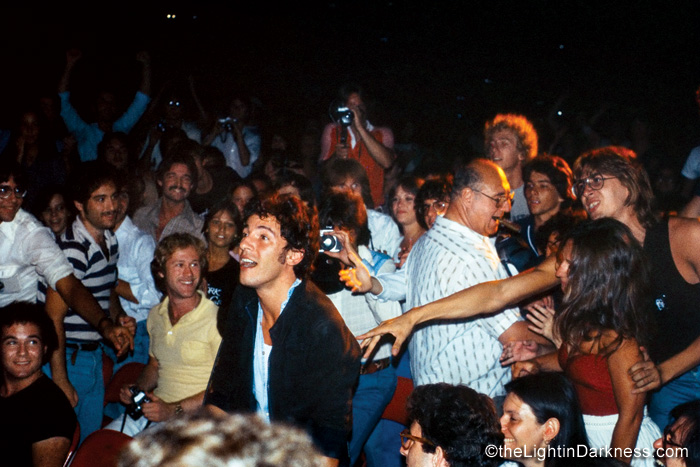 Occasionally, a record appears that changes fundamentally the way we hear rock & roll, the way it’s recorded, the way it’s played. Such records — Jimi Hendrix’ Are You Experienced, Bob Dylan’s “Like a Rolling Stone,” Van Morrison’s Astral Weeks, Who’s Next, The Band — force response, both from the musical community and the audience. To me, these are the records justifiably called classics, and I have no doubt that Bruce Springsteen’s
Occasionally, a record appears that changes fundamentally the way we hear rock & roll, the way it’s recorded, the way it’s played. Such records — Jimi Hendrix’ Are You Experienced, Bob Dylan’s “Like a Rolling Stone,” Van Morrison’s Astral Weeks, Who’s Next, The Band — force response, both from the musical community and the audience. To me, these are the records justifiably called classics, and I have no doubt that Bruce Springsteen’s 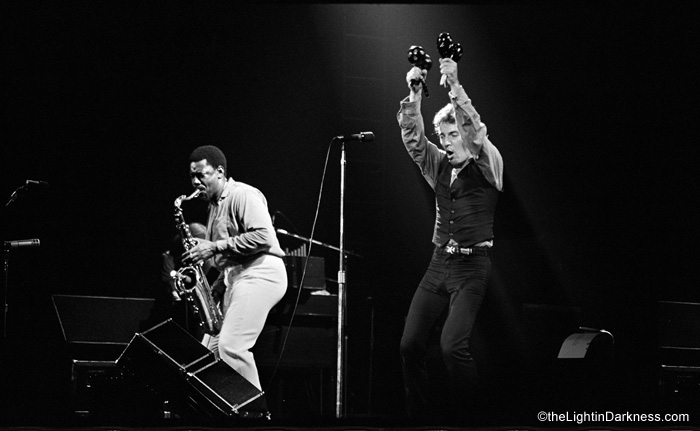 One could say a great deal about the construction of this LP. The programming alone is impressive: each side is a discrete progression of similar lyrical and musical themes, and the whole is a more universal version of the same picture. Ideas, characters and phrases jump from song to song like threads in a tapestry, and everything’s one long interrelationship. But all of these elements — the production, the playing, even the programming — are designed to focus our attention on what Springsteen has to tell us about the last three years of his life.
One could say a great deal about the construction of this LP. The programming alone is impressive: each side is a discrete progression of similar lyrical and musical themes, and the whole is a more universal version of the same picture. Ideas, characters and phrases jump from song to song like threads in a tapestry, and everything’s one long interrelationship. But all of these elements — the production, the playing, even the programming — are designed to focus our attention on what Springsteen has to tell us about the last three years of his life.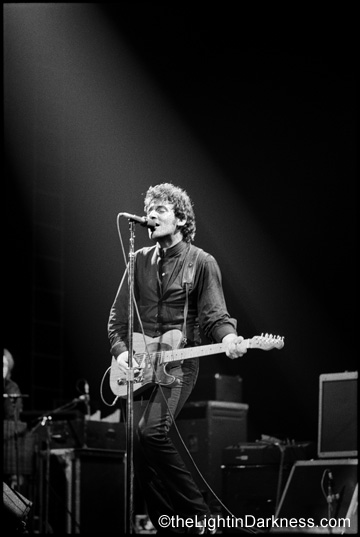 Bruce Springsteen has a tendency to inspire messianic regard in his fans — including this one. This isn’t so much because he’s regarded as a savior — though his influence has already been substantial — but because he fulfills the rock tradition in so many ways. Like Elvis Presley and Buddy Holly, Springsteen has the ability, and the zeal, to do it all. For many years, rock & roll has been splintered between the West Coast’s monopoly on the genre’s lyrical and pastoral characteristics and a British and Middle American stranglehold on toughness and raw power. Springsteen unites these aspects: he’s the only artist I can think of who’s simultaneously comparable to Jackson Browne and Pete Townshend. Just as the production of this record unifies certain technical trends, Springsteen’s presentation makes rock itself whole again. This is true musically — he rocks as hard as a punk, but with the verbal grace of a singer/songwriter — and especially emotionally. If these songs are about experienced adulthood, they sacrifice none of rock & roll’s adolescent innocence. Springsteen escapes the narrow dogmatism of both Old Wave and New, and the music’s possibilities are once again limitless
Bruce Springsteen has a tendency to inspire messianic regard in his fans — including this one. This isn’t so much because he’s regarded as a savior — though his influence has already been substantial — but because he fulfills the rock tradition in so many ways. Like Elvis Presley and Buddy Holly, Springsteen has the ability, and the zeal, to do it all. For many years, rock & roll has been splintered between the West Coast’s monopoly on the genre’s lyrical and pastoral characteristics and a British and Middle American stranglehold on toughness and raw power. Springsteen unites these aspects: he’s the only artist I can think of who’s simultaneously comparable to Jackson Browne and Pete Townshend. Just as the production of this record unifies certain technical trends, Springsteen’s presentation makes rock itself whole again. This is true musically — he rocks as hard as a punk, but with the verbal grace of a singer/songwriter — and especially emotionally. If these songs are about experienced adulthood, they sacrifice none of rock & roll’s adolescent innocence. Springsteen escapes the narrow dogmatism of both Old Wave and New, and the music’s possibilities are once again limitless